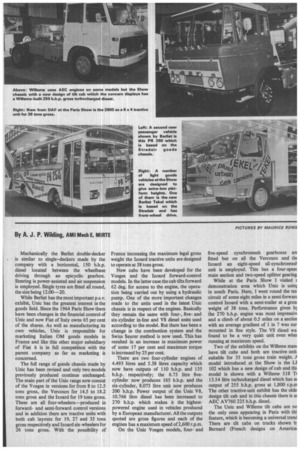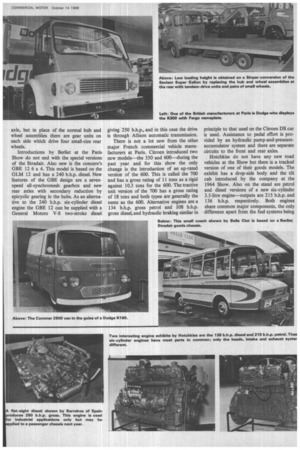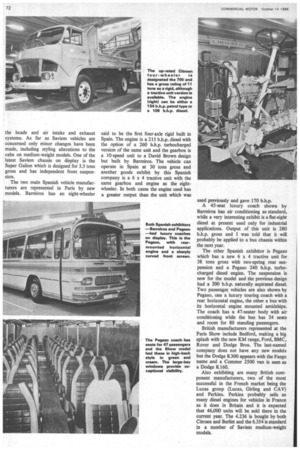Show Stealer by Berliet in Paris
Page 70

Page 71

Page 72

Page 73

Page 74

If you've noticed an error in this article please click here to report it so we can fix it.
ALMOST all the interest at the Paris Show this year is restricted to the stands of French manufacturers. Berliet and Unic have important new introductions and Saviem has made some changes to its range of models. But apart from these the only introductions of any note are by DAF of Holland and Pegaso and Barreiros of Spain. One of the new goods designs from Berliet is a light vehicle giving extremely low loading height and this is a feature of a number of other chassis—mainly conversions—to be seen at the Show, which closes tomorrow.
Undoubtedly, the Show stealer is a doubledeck bus featured by Berliet. The appearance of the model—one of an order of 25 for the passenger transport board of Paris—is stark to British eyes, with a square-cut aspect at the front and rear. Some would say that the vehicle looks ugly and that it follows the lines of old-fashioned trams. But the impression given is that the bus is designed to be practical rather than pretty and the lower saloon follows the pattern of single-decker buses used in France.
There is a wide entrance at the rear with a passenger-congregating area behind the "conductor's desk" and there is an exit just forward of the rear axle and a second at the extreme front. Access to the upper deck is by a rear staircase and a second staircase forward of this is for descending passengers. The design provides for 16 seated passengers and 40 standees downstairs and 38 seated on the upper deck.
The body panelling and supports are of light alloy and the floor to the upper deck together with the roof are of reinforced plastics with light-alloy framing. Overall length is 9.75 m. (32 ft.) and overall height is 4.35 m. (14.2 ft.). Interior headroom is 1.85 m. (6 ft. 1 in.) downstairs and 1.73 m. (5 ft. 8 in.) upstairs. Mechanically the Berliet double-decker is similar to single-deckers made by the company with a horizontal, 150 b.h.p. diesel located between the wheelbase driving through an epicyclic gearbox. Steering is power-assisted and air suspension is employed. Single tyres are fitted all round, the size being 12.00-20.
While Berliet has the most important p.s.v. exhibit, Unic has the greatest interest in the goods field. Since the 1964 Paris Show there have been changes in the financial control of Unic and now Fiat of Italy owns 65 per cent of the shares. As well as manufacturing its own vehicles, Unic is responsible for marketing Italian OM goods models in France and like this other major subsidiary of Fiat it is in full competition with the parent company as far as marketing is concerned.
The full range of goods chassis made by Unic has been revised and only two models previously produced continue unchanged. The main part of the Unic range now consist of the Vosges in versions for from 8 to 12.5 tons gross, the Vercours for 14.5 to 18.2 tons gross and the hoard for 19 tons gross. These are all four-wheelers--produced in forwardand semi-forward control versions and in addition there are tractive units with both cab layouts for 19, 27 and 35 tons gross respectively and Izoard six-wheelers for 26 tons gross. With the possibility of France increasing the maximum legal gross weight the Izoard tractive units are designed to operate at 38 tons gross.
New cabs have been developed for the Vosges and the Izoard forward-control models. In the latter case the cab tilts forward 62 deg. for access to the engine, the operation being carried out by using a hydraulic pump. One of the more important changes made to the units used in the latest Unic chassis is in respect of the engines. Basically they remain the same with four-, fiveand six-cylinder in-line and V8 diesel units used according to the model. But there has been a change in the combustion system and the Swiss Salver method is now used. This has resulted in an increase in maximum power of some 17 per cent and maximum torque is increased by 25 per cent.
There are two four-cylinder engines of 4.493 litres and 5.38 litres capacity which now have outputs of 110 b.h.p. and 135 b.h.p. respectively; the 6.73 litre fivecylinder now produces 165 b.h.p. and the six-cylinder, 8.075 litre unit now produces 200 b.h.p. Power output of the Unic V8, 10.766 litre diesel has been increased to 270 b.h.p. which makes it the highestpowered engine used in vehicles produced by a European manufacturer. All the outputs quoted are gross figures and each of the engines has a maximum speed of 2,600 r.p.m.
On the Unic Vosges models, fourand five-speed synchromesh gearboxes art fitted but on all the Vercours and du Izoard an eight-speed all-synchromest unit is employed. This has a four-speec main section and two-speed splitter gearing
While at the Paris Show I visited demonstration area which Unic is• using in south Paris. Here, I went round the tes circuit of some eight miles in a semi-forwart control hoard with a semi-trailer at a gros! weight of 38 tons. Performance given b3 the 270 b.h.p. engine was most impressiv4 and a climb of about 0.5 miles on a sectior with an average gradient of 1 in 7 was sur mounted in fine style. The V8 diesel wa found to be a very quiet unit even whet running at maximum speed.
Two of the exhibits on the Willeme stall( have tilt cabs and both are tractive unit suitable for 35 tons gross train weight. model introduced at the Show is the LI 102 which has a new design of cab and tin; model is shown with a Willeme 518 T4 13.54 liti-e turbocharged diesel which has al output of 255 b.h.p. gross at 1,800 r.p.In The other tractive-unit exhibit has the olde design tilt cab and in this chassis there is al AEC AV760 225 b.h.p. diesel.
The Unic and Willeme tilt cabs are no the only ones appearing in Paris with thi feature, which is becoming a universal trend There are tilt cabs on trucks shown b: Bernard (French designs on America] chassis), Hotchkiss, International, Henschel, Volvo, Krupp, Magirus-Deutz and Dodge exhibits. In the last case the model is a K300 which carries the Fargo nameplate. This is the first time that I have seen a Dodge 500 Series chassis shown with this name, and it is also the first time that I have seen a Commer 2500 van appear as a K160 as it does at the Paris Show.
The only non-French company to show a significant new model is DAF of Holland and the two models that the company displays that can be put into this category are, in fact, versions of existing chassis. Both are 6 x 4 designs. The Ti' 2600 DP is a tractive unit which is suitable for a gross train weight of 42 tons for normal road use or for up to 60 tons on special applications. The 2600 has the square-design DAF cab and this is the first time that a six-wheeler has been fitted with this unit. The tandemdrive rear axles are carried on two-spring suspension as used on the DAF 1900 series and the engine is an 11.1 litre 226 b.h.p. gross diesel which drives through a sixspeed main gearbox and two-speed splitter box. The second new DAF 6 x 4 is the ATE 2400 DP and this is designed for use as a tipper at 26 tons gross. This class of machine is very popular in France for road building and so on and between 1,000 and 1,200 are put into service there annually. Because of the excessive overloading said to be common in France with tippers, the DAF design is more robust than would appear to be absolutely necessary. In general the chassis is similar to the 2600 except that the older-style DAF cab is employed and a three-speed splitter gearbox is fitted to give extra-low gearing.
As well as appearing in the vehicle section of the Show, DAF is taking part in the trailer section and of interest here is an example of a semi-trailer from a range now offered by the company to meet the requirements of operators handling containers. Models suitable for ISO containers, SeaLand containers and Flexi-vans are included.
Interest on the Berliet stand is not limited to the double-decker, for the company has two other new models which are based on the Stradair medium-weight goods design. One of these is the PR 250 coach, and the other is While the Tekel is based on the Stradair it is very different mechanically. Front-wheel drive is used so that the frame height can be lowered as much as possible and tandem axles replace the rear driving axle. Air suspension is used at the rear and 6.00-9 tyres are fitted. But to get an adequate turning circle with the frontwheel drive, leaf springs replace the combined air/leaf suspension standard on the Stradair and the front tyre size is unchanged at 8.00-19.5. Platform height of the chassis on the stand is 2 ft. 1 in. and the standard engine in the model is a Perkins 4.236 four cylinder 80 b.h.p. diesel which drives through a five-speed synchromesh gearbox mounted as a unit with the engine. The drive is taken over the front axle to a transfer box half way down the chassis and then returned to the centre of the axle.
There appears to be a trend in France towards using front-wheel drive on the lighter goods chassis to obtain low platform heights. Other exhibits with this feature shown include a model on the Sovam stand which has independent front suspension. A difference between this model and the Berliet Tekel is that the same size tyres are fitted at the front and rear which with a platform height of 1 ft. 6 in. means that there are wheel boxes at the rear.
One use for the Sovam that is apparent at the Show is as the basis for mobile "market stalls". On the stand of Etalmobil, a bodybuilding associate of Sovam, one of the chassis has a body of this type. The roof and floor of the body extend to make the overall length at least half as much again as the basic platform and with the addition of shelving the vehicle provides extensive display facilities.
Other low-loading vehicles of the same type to be seen at Paris include a conversion by Sinpar of a Saviem Super Galion. On this model the drive layout of the rear is retained together with most of the rear axle, but in place of the normal hub and wheel assemblies there are gear units on each side which drive four small-size rear wheels.
Introductions by Berliet at the Paris Show do not end with the special versions of the Stradair. Also new is the concern's GBE 12 6 x 4. This model is based on the GLM 12 and has a 240 b.h.p. diesel. New features of the GBE design are a sevenspeed all-synchromesh gearbox and new rear axles with secondary reduction by epicyclic gearing in the hubs. As an alternative to the 240 b.h.p. six-cylinder diesel engine the GBE 12 can be supplied with a General Motors V-8 two-stroke diesel giving 250 b.h.p., and in this case the drive is through Allison automatic transmission.
There is not a lot new from the other major French commercial vehicle manufacturers at Paris. Citroen introduced two new models—the 350 and 600 during the past year and for this show the only change is the introduction of an up-rated version of the 600. This is called the 700 and has a gross rating of 11 tons as a rigid against 10.3 tons for the 600. The tractive unit version of the 700 has a gross rating of 18 tons and both types are generally the same as the 600. Alternative engines are a 134 b.h.p. gross petrol and 108 b.h.p. gross diesel, and hydraulic braking similar in principle to that used on the Citroen DS car is used. Assistance to pedal effort is provided by an hydraulic pump-and-pressureaccumulator system and there are separate circuits to the front and rear axles.
Hotchkiss do not have any new road vehicles at the Show but there is a tracked version of one of their goods models. The exhibit has a drop-side body and the tilt cab introduced by the company at the 1964 Show. Also on the stand are petrol and diesel versions of a new six-cylinder 3.5-litre engine—outputs are 215 b.h.p. and 136 b.h.p. respectively. Both engines share common major components, the only difference apart from the fuel systems being the heads and air intake and exhaust systems. As far as Saviem vehicles are concerned only minor changes have been made, including styling alterations to the cabs on medium-weight models. One of the latest Saviem chassis on display is the Super Galion which is designed for 3.5 tons gross and has independent front suspension.
The two main Spanish vehicle manufacturers are represented in Paris by new models. Barreiros has an eight-wheeler said to be the first four-axle rigid built in Spain. The engine is a 215 b.h.p. diesel with the option of a 260 b.h.p. turbocharged version of the same unit and the gearbox is a 10-speed unit to a David Brown design but built by Barreiros. The vehicle can operate in Spain at 30 tons gross and another goods exhibit by this Spanish company is a 6 x 4 tractive unit with the same gearbox and engine as the eightwheeler. In both cases the engine used has a greater output than the unit which was used previously and gave 170 b.h.p.
A 45-seat luxury coach shown by Barreiros has air conditioning as standard, while a very interesting exhibit is a flat-eight diesel at present used only for industrial applications. Output of this unit is 280 b.h.p. gross and I was told that it will probably be applied to a bus chassis within the next year.
The other Spanish exhibitor is Pegaso which has a new 6 x 4 tractive unit for 38 tons gross with two-spring rear suspension and a Pegaso 240 b.h.p. turbocharged diesel engine. The suspension is new for the model and the previous design had a 200 b.h.p. naturally aspirated diesel. Two passenger vehicles are also shown by Pegaso, one a luxury touring coach with a rear horizontal engine, the other a bus with its horizontal engine mounted amidships. The coach has a 47-seater body with air conditioning while the bus has 24 seats and room for 80 standing passengers.
British manufacturers represented at the Paris Show include Bedford, making a big splash with the new KM range, Ford, BMC, Rover and Dodge Bros. The last-named company does not have any new models but the Dodge K300 appears with the Fargo name and a Conuner 2500 van is seen as a Dodge K160.
Also exhibiting are many British component manufacturers, two of the most successful in the French market being the Lucas group (Lucas, Girling and CAV) and Perkins. Perkins probably sells as many diesel engines for vehicles in France as it does in Britain and it is expected that 46,000 units will be sold there in the current year. The 4.236 is bought by both Citroen and Berliet and the 6.354 is standard in a number of Saviem medium-weight models.
































































































































